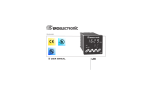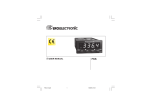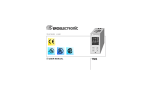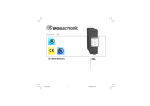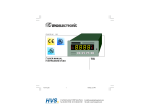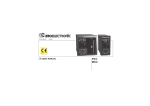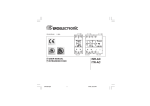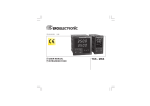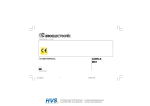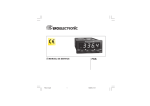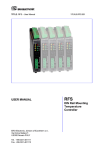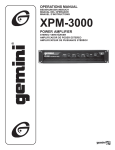Download TIS TIS MK1 - E
Transcript
170.IU0.TIS.100 3.4-98/A r USER MANUAL TIS TIS MK1 TIS APPROVALS INDEX MOUNTING REQUIREMENTS .......................... 1 OUTLINE AND CUT OUT DIMENSIONS ........... 2 CONNECTION DIAGRAMS ................................ 3 PRELIMINARY HARDWARE SETTINGS ........... 9 CONFIGURATION PROCEDURE .................... 10 OPERATIVE MODE .......................................... 15 Indicators ................................................... 15 Pushbutton function ................................... 15 Alarm setting .............................................. 16 Manual reset of the alarms ........................ 16 Alarm indications ....................................... 16 Peak high and peak low ............................ 16 OPERATIVE PARAMETERS ............................ 17 ERROR MESSAGES ........................................ 18 GENERAL INFORMATIONS ............................ 20 DEFAULT PARAMETERS ............................... A.1 TIS MK1 APPROVALS While holding the instrument against the panel proceed as follows: 1) insert the gasket in the instrument case; 2) insert the instrument in the panel cutout; 3) pushing the instrument against the panel, insert the mounting bracket; 4) with a screwdriver, turn the screws with a torque between 0.3 and 0.4 Nm. MOUNTING REQUIREMENTS Select a mounting location where there is minimum vibration and the ambient temperature range between 0 and 50 °C. The instrument can be mounted on a panel up to 15 mm thick with a square cutout of 45 x 92 mm. For outline and cutout dimensions refer to Fig. 2. The surface texture of the panel must be better than 6,3 µm. The instrument is shipped with rubber panel gasket (50 to 60 Sh). To assure the IP65 and NEMA 4 protection, insert the panel gasket between the instrument and the panel as show in fig. 1. Gasket Bracket Panel Fig. 1 GB 1 OUTLINE AND CUT OUT DIMENSIONS Fig. 2.A TIS - OUTLINE AND CUT-OUT DIMENSIONS GB 2 CONNECTION DIAGRAMS Connections are to be made with the instrument housing installed in its proper location. Fig. 3 .A TIS - REAR TERMINAL BLOCK GB 3 Fig. 2.2.B REAR TERMINAL BLOCK FOR MODEL TIS MK1 GB 4 NOTE: a single switch or circuit-breaker can drive more than one instrument. A) POWER LINE WIRING N (L2) P(L1) Fig. 4 POWER LINE WIRING P(L1) 13 POWER LINE 100 V to 240 V A.C (50/60Hz) or 24 V AC/DC B) MEASURING INPUTS NOTE: Any external components (like zener barriers etc.) connected between sensor and input terminals may cause errors in measurement due to excessive and/or not balanced line resistance or possible leakage currents. N(L2) 12 NOTE: 1) Before connecting the instrument to the power line, make sure that line voltage corresponds to the descrtiption on the identification label. 2) To avoid electric shock, connect power line at the end of the wiring procedure. 3) For supply connections use No 16 AWG or larger wires rated for at last 75 °C. 4) Use cupper conductors only. 5) Don’t run input wires together with power cables. 6) For 24 V DC the polarity is a not care condition. 7) The power supply input is NOT fuse protected. Please, provide it externally. Power supply Type Current Voltage 24 V AC/DC T 500 mA 250 V 100/240 V AC T 125 mA 250 V When fuse is damaged, it is advisable to verify the power supply circuit, so that it is necessary to sand back the instrument to your supplier. 8) The safety requirements for Permanently Connected Equipment say: - a switch or circuit-breaker shall be included in the building installation; - It shall be in close proximity to the equipment and within easy reach of the operator; - it shall be marked as the disconnecting device for the equipment. GB TC INPUT + 1 _ 3 Shield + 1 _ 3 Shield Fig. 5 THERMOCOUPLE INPUT WIRING NOTE: 1) Don’t run input wires together with power cables. 2) For TC wiring use proper compensating cable preferable shielded. 3) when a shielded cable is used, it should be connected at one point only. 5 RTD INPUT LINEAR INPUT RTD RTD 6 7 + _ mA, mV or V Shield 4 3 1 4 3 6 1 7 Fig. 6 RTD INPUT WIRING + _ mA mV or V G NOTE: 1) Don’t run input wires together with power cables. 2) Pay attention to the line resistance; a high line resistance may cause measurement errors. 3) When shielded cable is used, it should be grounded at one side only to avoid ground loop currents. 4) The resistance of the 3 wires must be the same. GB Fig. 7 mA, mV AND V INPUTS WIRING NOTE: 1) Don’t run input wires together with power cables. 2) Pay attention to the line resistance; a high line resistance may cause measurement errors. 3) When shielded cable is used, it should be grounded at one side only to avoid ground loop currents. 4) The input impedance is equal to: < 5 Ω for 20 mA input > 1 MΩ for 60 mV input > 200 kΩ for 5 V input > 400 kΩ for 10 V input 6 C) RELAY OUTPUTS ALARM 3 RELAY OUTPUT (TIS only) ALARM 1 AND ALARM 2 RELAY OUTPUTS 17 ALARM 2 18 19 20 ALARM 1 21 22 NO 11 C ALARM 3 10 NO C NC NO Fig. 9 ALARM 3 RELAY WIRING C All relay outputs are NOT protected against inductive load. The contact ratings are: - 2 A / 30 V DC on resistive load or - 2 A / 250 V AC on resistive load The MTBF is 2 x 105 at specified rating. NOTES 1) To avoid electric shock, connect power line at the end of the wiring procedure. 2) For power connections use No 16 AWG or larger wires rated for at last 75 °C. 3) Use cupper conductors only. 4) Don’t run input wires together with power cables. NC Fig. 8 ALARM 1 AND ALARM 2 RELAY WIRING All relay outputs are NOT protected against inductive load. The contact ratings are: - 3 A / 30 V DC on resistive load or - 3 A / 250 V AC on resistive load The MTBF is 2 x 105 at specified rating. NOTES 1) To avoid electric shock, connect power line at the end of the wiring procedure. 2) For power connections use No 16 AWG or larger wires rated for at last 75 °C. 3) Use cupper conductors only. 4) Don’t run input wires together with power cables. GB The following recommendations avoid serious problems which may occur, when using relay output for driving inductive loads. 7 INDUCTIVE LOADS F) ANALOG RETRANSMISSION OUTPUT (TIS MK1 only) _ High voltage transients may occur when switching inductive loads. Through the internal contacts these transients may introduce disturbances which can affect the performance of the instrument. In this case it is recommended to install an additional RC network close to the instrument terminals. The same problem may occur when a switch is used in series with the internal contacts as shown in Fig. 10. C R 11 LOAD 10 Fig. 11 ANALOG RETRANSMISSION OUTPUT WIRING NOTES: 1) Don’t run analog retransmission wires together with power cables. 2) When shielded cable is used, it should be grounded at one side only to avoid ground loop currents. 3) For mA output the max. load is equal to 500 Ω. For V output the min. load is equal to 5 kΩ. POWER LINE LOAD Fig. 10 EXTERNAL SWITCH IN SERIES WITH THE INTERNAL CONTACT In this cases it is recommended to install an additional RC network across the external contact and close to the instrument terminals. The value of capacitor (C) and resistor (R) are shown in the following table. LOAD (mA) C (µF) R (Ω) P. (W) OPERATING VOLTAGE <40 mA 0.047 100 <150 mA 0.1 22 <0.5 A 0.33 47 1/2 2 2 260 V AC 260 V AC 260 V AC Anyway the cable involved in relay output wiring must be as far away as possible from input or communication cables. GB + 8 3) This instrument is able to identify the open circuit for TC and RTD inputs. The open input circuit condition for RTD input is shown by an "overrange" indication. For TC input, it is possible to select overrange indication (standard) or underrange indication setting the CH2 and SH2 according to the following table: Overrange (STD) CH2 = close SH2 = open Underrange CH2 = open SH2 = close PRELIMINARY HARDWARE SETTINGS 1) Remove the instrument from its case. 2) When an analog input different from factory setting (0-20mA) is desired, the jumper J602 and J603 should be set properly in accordance with the table below: Both pads are located on the soldering side of the CPU card J602 J603 Fig. 12 input = 60 mV fsv input = 5 V fsv input = 10 V fsv input = 20 mA fsv Fig. 13 GB 9 SH2 CH2 3) The instrument is shipped with a 20 mA ( standard) analog re-transmission (TIS MK1 only). When it is desired to use a 10 V analog retransmission, the soldering jumper named SH 5, 6, 7, 8 and 9 should be set properly in accordance with the table below: GENERAL NOTES for configuration. F= R = s Output SH 5 SH 6 SH 7 SH 8 SH 9 20 mA open open open open open 10 V close close close close close t It allows to memorize the new value of the selected parameter and go to the next parameter (increasing order). It allows to scroll back the parameters without memorization of the new value. = It allows to increase the value of the selected parameter = It allows to decrease the value of the selected parameter. CONFIGURATION PROCEDURE 1) Remove the instrument from its case. 2) Set the dip switch V2 in open condition. SH 5 SH 6 SH 7 SH 8 SH 9 Fig. 14 V2 Fig. 15 GB 10 3) Re-insert the instrument. 4) Switch on the instrument. The display will show COnF. NOTE : If "CAL" indication will be displayed, press immediately the s pushbutton and return to the configuration procedure. 5) Push the FUNC pushbutton. P1 - Input type and standard range 0 = TC type L range -100 / +900 °C 1 = TC type J range -100 / +1000 °C 2 = TC type K range -100 / +1370 °C 3 = TC type T range -100/ +400 °C 4 = TC type N range 0 / +1400 °C 5 = TC type R range 0 / +1760 °C 6 = TC type S range 0 / +1760 °C 7 = RTD type Pt 100 range -200 / +600 °C 8 = RTD type Pt 100 range -199.9/+600.0 °C 9 = Linear 0 - 20 mA 10 = Linear 0 - 60 mV 11 = Linear 0- 5 V 12 = Linear 0 - 10 V 13 = Linear 4 - 20 mA 14 = Linear 12 - 60 mV 15 = Linear 1- 5 V 16 = Linear 2 - 10 V 17 = TC type L range -150 / +1650 °F 18 = TC type J range -150 / +1850 °F 19 = TC type K range -150 / +2500 °F 20 = TC type T range -150/ +750 °F 21 = TC type N range 0 / +2550 °F 22 = TC type R range 0 / +3200 °F 23 = TC type S range 0 / +3200 °F 24 = RTD type Pt 100 range -320 / +1100 °F GB 11 P2 = Decimal point position This parameter is available only when a linear input is selected (P1 = 9, 10, 11, 12, 13, 14, 15 or 16). 0 = No decimal figure. 1 = One decimal figure. 2 = Two decimal figures. 3 = Three decimal figures. P3 = Initial scale value (for linear inputs only) This parameter is available only when a linear input is selected (P1 = 9, 10, 11, 12, 13, 14, 15 or 16). Insert the readout value related with the initial range value (i.e. if P1 = 13 (4 - 20 mA) and P3 is set to -100; the instrument shows -100 when the input signal is equal to 4 mA). P3 is programmable between -1999 and 4000. P4 = Full scale value (for linear input) This parameter is available only when a linear input is selected (P1 = 9, 10, 11, 12, 13, 14, 15 or 16). Insert the readout value related with the full range value (i.e. if P1 = 13 and P4 is set to 3500; the instrument shows 3500 when the input signal is equal to 20 mA) P4 is programmable between -1999 and 4000. NOTE: setting a P3 value greatest than P4 value, the readout scale will be revert. P5 = Digital filter on the measured value This parameter sets the desired time constant of a digital filter applied to the measured value. This filter will be operative also on alarm functions and analog retransmission (TIS MK1 only). 0 = no digital filter 1 = digital filter with 1 second time constant. 2 = digital filter with 2 seconds time constant. 3 = digital filter with 3 seconds time constant. 4 = digital filter with 4 seconds time constant. 5 = digital filter with 5 seconds time constant. P6 = Alarm 1 configuration OFF = Alarm not used HA = High alarm with automatic reset LA = Low alarm with automatic reset HL = High alarm with manual reset LL = low alarm with manual reset P10 = Threshold of the alarm 1 Available only when P9 = YES Insert the desired value in engineering units. P7 = Alarm 1 action Available only when P6 is other than OFF. rEV = reverse (relay de-energized in alarm condition) dir = direct (relay energized in alarm condition) P8 = Stand by (mask) of the alarm 1 Available only when P6 is other than OFF. OFF = stand by (mask) disabled ON = stand by (mask) enabled NOTE: the alarm stand by function operates as follows: it masks, at start up, an alarm condition. The alarm will resume its functionality after the initial alarm condition was disappeared. (See P18 parameter as variation of this alarm masking procedure) P9 = Threshold and hysteresis of the alarm 1 programmable during configuration procedure nO = Threshold and hysteresis of the alarm 1 are programmable during the operative mode. YES = Threshold and hysteresis of the alarm 1 are programmable during the configuration procedure. GB 12 P11 = Hysteresis of the alarm 1 Available only when P9 = YES Insert the desired value in % of the readout span. P11 is programmable between 0.1 and 10.0 % of the readout span. P12 = Alarm 2 configuration OFF = Alarm not used HA = High alarm with automatic reset LA = Low alarm with automatic reset HL = High alarm with manual reset LL = Low alarm with manual reset P13 = Alarm 2 action Available only when P12 is other than OFF. rEV = Reverse (relay de-energized in alarm condition) dir = Direct (relay energized in alarm condition) P14 = Stand by (mask) of the alarm 2 Available only when P12 is other than OFF. OFF = Stand by (mask) disabled ON = Stand by (mask) enabled NOTE: the alarm stand by function operates as follows: it masks, at start up, an alarm condition. The alarm will resume its functionality after the initial alarm condition was disappeared. (See also P18 parameter) P15 = Alarm 3 configuration OFF = analog retransmission enabled (TIS MK1 only) or alarm 3 not used HA = High alarm with automatic reset LA = Low alarm with automatic reset HL = High alarm with manual reset LL = Low alarm with manual reset P16 = Alarm 3 action (for TIS only) Available only when P15 is other than OFF. rEV = Reverse (relay de-energized in alarm condition) dir = Direct (relay energized in alarm condition) P17 = Stand by (mask) of the alarm 3 (for TIS only) Available only when P15 is other than OFF. OFF = Stand by (mask) disabled ON = Stand by (mask) enabled NOTE: the alarm stand by function operates as follows: it masks, at start up, an alarm condition. The alarm will resume its functionality after the initial alarm condition was disappeared. (See also P18 parameter) P18 = Delay on the alarm stand by This parameter will appear on the display only if at least one of the alarms is configured as a "stand by" alarm. It is programmable between 0 and 120 seconds; when P18 = 0 no delay is applied. NOTE: This is a delay (during this time the alarms are OFF) which occurs from “start up” to the beginning of the masking procedure and it allows to ignore an initial oscillations or peaks present on the input signal at system start up. GB 13 P19 = OFFSET on the measured value. This parameter allows to add an OFFSET (in engineering unit) on the measured value. P19 is programmable: a) from -200 to +200 eng. units for - linear inputs (mA and V). - TC with °C readout. - RTD with °C readout and whithout decimal figure. b) from -20.0 to +20.0 eng. units for RTD with °C readout and whith decimal figure. c) from -360 to +360 eng. unit for TC and RTD with °F readout. P20 = Safety lock Not available when P6, P12 and P15 are equal to OFF 0 = Device unlocked. All the parameters can be modified during operative mode. 1 = Device locked. No parameter can be modified. 2 to 999 = Select the secret code (to be remember) and, during the "operative mode", scrolling the "software key" parameter, the display will show one of the following figures: A) nnn and OFF alternately. The device is "Unlocked" and all parameters can be modified. To make the device "Locked" insert a number different from the "secret code". Now no parameter can be modified. B) nnn and On alternately. The device is "locked" and no one of the parameters can be modified. To "Unlock" the device, insert the "secret code". P21 - Re-transmission type (TIS MK1 only) This parameter is available only if P15=OFF OFF = Re-transmission not provided 0-20 = 0-20mA retransmission (or 0-10V) 4-20 = 4-20mA retransmission (or 2-10V) P22 - Initial scale value for analog re-transmission (TIS MK1 only) This parameter is available only if P15=OFF and P21 different from OFF Between -1999 and 6000 eng. units. P23 - Full scale value for analog retransmission (TIS MK1 only). This parameter is available only if P15=OFF and P21 different from OFF Between -1999 and 6000 eng. units. NOTE: it is possible to revert the re-transmitted signal by setting P22 lower than P23. The configuration procedure is completed and the instrument shows " COnF ". GB 14 OPERATIVE MODE 1) Remove the instrument from its case. 2) Set the internal dip switch V2 (see fig. 15) in closed condition 3) Re-insert the instrument. 4) Switch on the instrument. The instrument shows the measured value. INDICATORS °C Lit when the process variable is shown in Celsius degree. °F Lit when the process variable is shown in Fahrenheit degree. Pushbutton functionality during operating mode. F = It is used to memorize the new value of the selected parameter and go to the next parameter (increasing order). R = It is used in combination with other pushbuttons, to clear peak high and peak low memory and for manual reset of the alarms. s = It is used to increase the value of the selected parameter or to display the peak high value. t = It is used to decrease the value of the selected parameteror to display the peak low value. R + t = Manual reset of the alarms AL 1 - AL 2 - AL3 Indicator OFF = no alarm condition NOTE: for TIS MK1 only, when the analog retransmission is programmed the AL3 LED is not used. Indicator ON = alarm condition Indicator flashing = the alarm condition was disappeared but the instrument is waiting for a manual reset of the alarm. PK Indicator OFF = instrument shows the measured value Indicator ON = instrument shows the "Peak high" value Indicator Flashing = instrument shows "Peak low" value GB 15 R + F = They are used to reset peak high and peak low and restart the peak detection procedure. s+t They are used to start the default parameters loading procedure. NOTE: a 10 seconds time out becomes operational during parameter modification. If, during operative parameter modification, no pushbutton is depressed for more than 10 seconds, the instrument automatically reverts to the “normal display mode”. The new setting of the last parameter modified is going to be memorized, prior to the time out, only if the F pushbutton was depressed. Alarm setting To display the alarm settings push the F pushbutton, the instrument will show alternately the alarm threshold code and its value. Push the F pushbutton again, the display will show the alarm hysteresis and its value. The sequence will continue with all the programmed alarms. NOTE: when the alarm 1 is programmed for setting during configuration procedure, the alarm 1 parameters will not displayed. To modify the alarm settings proceed as follows: 1) Using the F pushbutton select the desired alarm parameter. 2) Using the s and t pushbuttons, it is possible to set the desired value. 3) When the desired value is reached, push the F pushbutton, the new value will become operative and the display will show the next parameter. If, during this procedure, there is no interest in memorizing the new value, do not push any pushbutton for more than 10 seconds; the instrument automatically returns to the normal display mode without having memorized the new value. Manual reset of the alarms. To perform the manual reset of the alarm, depress the R pushbutton and, at the same time, push the t pushbutton. GB 16 Alarm indications The instrument front display will perform in 4 different ways as follows: 1) If no alarm conditions are detected the alarm indicators are OFF. 2) If an alarm condition is detected, the LED of the specific alarm lights up to show the alarm condition. 3) The alarm condition disappears and the alarm is configured for automatic reset; the LED of the alarm goes OFF to show that the alarm condition is not present any more. 4) The alarm condition disappears but the alarm is configured for manual reset; the LED of the alarm start flashing to show that the alarm condition is not present any more but the alarm has not been reset. Peak high and peak low The TIS is capable of memorizing the maximum and the minimum measured values. To display the maximum measured value, push the s pushbutton, the "PK" LED will light up and the display will show the maximum measured value. To return to display the actual measured value, push the s pushbutton again. To display the minimum measured value, push the t pushbutton, the "PK" LED will flash and the display will show the minimum measured value. To return to display the actual measured value, push the t pushbutton again. To reset the peak high and peak low memory (to clear both memories) push the R pushbutton and, at the same time, push the F pushbutton. Both values become equal to the actual measured value and the function automatically restarts. OPERATIVE PARAMETERS Push the F pushbutton, the display will show alternately the code of the selected parameter and the programmed value. H2 Param. DESCRIPTION nnn A1 A2 A3 H1 Software key for parameter protection. Not available when P6, P12 and P15 are equal to OFF This parameter is skipped if P20 = 0 or 1 ON = the instrument is in LOCK condition OFF = the instrument is in UNLOCK condition When it is desired to switch from LOCK to UNLOCK condition, set a value equal to P20 parameter. When it is desired to switch from UNLOCK to LOCK condition, set a value different from P20 parameter. Alarm 1 threshold This parameter is available only if P 6 is different from OFF and P9 is equal to nO. Ranges: within the input range. Alarm 2 threshold This parameter is available only if P 12 is different from OFF . Ranges: within the input range. Alarm 3 threshold This parameter is available only if P 15 is different from OFF. Ranges: within the input rang.. Alarm 1 hysteresis This parameter is available only if P 6 is different from OFF and P9 is equal to nO. GB 17 H3 Range:From 0.1% to 10.0% of the input span or 1 LSD. Alarm 2 hysteresis This parameter is available only if P 12 is different from OFF . Range:From 0.1% to 10.0% of the input span or 1 LSD. Alarm 3 hysteresis . This parameter is available only if P 15 is different from OFF. Range:From 0.1% to 10.0% of the input span or 1 LSD. ERROR MESSAGES OPEN INPUT CIRCUIT OUT OF RANGE The instrument shows the UNDER RANGE and the OVER RANGE with the following messages : This instrument is able to identify the open circuit for 4-20 mA, 1-5 V, 2-10 V and RTD inputs. The open input circuit condition is shown by "OPEn" on the display. For RTD, mA and V input the instrument associates this status to underrange condition . NOTE: For 4 - 20 mA, 1-5 V and 2-10 V inputs, the open input circuit condition is shown when the input signal is lower than the minimum range value minus 4 % of the input span. OVER RANGE UNDER RANGE During out of range indications, alarm status and peak detection operates as in presence of the range limits. NOTE: 1) The out of range indications follow the readout scaling so that if a reverse scaling is set, over range and under range are reversed also. 2) The out of range indications are shown when the input signal is 2% higher or 2% lower of the max. and min. scale values respectively. To eliminate the OUT OF RANGE condition, proceed as follows: 1) Check the input signal source and the connecting line. 2) Make sure that the input signal is in accordance with instrument configuration. Otherwise, modify the input configuration (see pages 9, 10 and 11). 3) Send back the instrument to your supplier for a check. GB 18 ERRORS Diagnostics are made at instrument switch-on and during normal mode of operation. If a fault condition (error) is detected, the display will show the message "E" followed by the relative error code. The following is a list of possible errors in numerical order. The causes, instrument output conditions and possible remedies are briefly described. Same errors reset the instrument; if the error persist, send back the instrument to your supplier. ERROR DESCRIPTIONS E100 EPROM writing error. It may appear during parameter modification or calibration procedure. The instrument resets itself automatically after 2 seconds. Remake the last procedure. If this error persists, send back the instrument to your supplier. E150 CPU error. It may appear at instrument switching on. The instrument resets itself automatically after 2 seconds. If this error persists, send back the instrument to your supplier. E200 Tentative to write on protected memory. The instrument resets itself automatically after 2 seconds. If this error persists, send back the instrument to your supplier. E201 to 2XX. The two less significant digit’s shown the number of the wrong parameter (ex. 209 Err shows an Error on P9 parameter) Incorrect configuration data in EPROM memory. It may appear at instrument switching on in operative mode. The instrument does not start to operate. Remake the configuration procedure. If this error persists, send back the instrument to your supplier. E301 RTD input calibration error. It may appear at instrument switching on. The instrument resets itself automatically after 2 seconds. Remake the calibration procedure. If this error persists, send back the instrument to your supplier. GB 19 E305 TC input calibration error. It may appear at instrument switching on. The instrument resets itself automatically after 2 seconds. Remake the calibration procedure. If this error persists, send back the instrument to your supplier. E307 rj input calibration error. It may appear at instrument switching on. The instrument resets itself automatically after 2 seconds. Remake the calibration procedure. If this error persists, send back the instrument to your supplier. E310 Linear input calibration error. It may appear at instrument switching on. The instrument resets itself automatically after 2 seconds. Remake the calibration procedure. If this error persists, send back the instrument to your supplier. E400 The alarm threshold values are incompatible with the actual readout range or their values in memory are incorrect. It may appear at instrument switching on in operative mode. The instrument does not start to operate. Push contemporarily s and t pushbutton and force the threshold values at the initial scale value. Set the desired threshold values. GENERAL INFORMATIONS GENERAL SPECIFICATIONS Case: PC-ABS black color; self-extinguishing degree: V-0 according to UL 94. Front protection - designed and tested for IP 65 (*) and NEMA 4X (*) for indoor locations (when panel gasket is installed). (*) Test were performed in accordance with CEI 701 and NEMA 250-1991 STD. Installation: panel mounting. Rear terminal block:21 screw terminals ( screw M3, for cables from φ 0.25 to φ 2.5 mm2 or from AWG 22 to AWG 14 ) with connection diagrams and safety rear cover. Dimensions: DIN 43700 48 x 96 mm, depth 89 mm. Weight: 350 g. Power supply: - 100V to 240V AC 50/60Hz (-15% to + 10% of the nominal value). - 24 V AC/DC (+ 10 % of the nominal value). Power consumption: 8 VA max. Insulation resistance: > 100 MΩ according to IEC 1010-1. Dielectric strength: 1500 V rms according to IEC 1010-1. Display updating time: 500 ms. Sampling time: 250 ms typical. Resolution: 30000 counts. Accuracy: + 0,2% f.s.v.. + 1 digit @ 25 °C ambient temperature. Common mode rejection: 120 dB at 50/60 Hz. Normal mode rejection: 60 dB at 50/60 Hz. Electromagnetic compatibility: This instrument is marked CE. Therefore, it is conforming to council directive 89/ 336/EEC (reference harmonized standard EN50081-2 and EN-50082-2) Installation category: II GB 20 Temperature drift: (CJ excluded) < 200 ppm/°C of span for TC inputs (RJ excluded) < 300 ppm/°C of span for mA/V inputs < 400 ppm/°C of span for RTD inputs. Operative temperature: from 0 to 50 °C. Storage temperature : -20 to +70 °C Humidity: from 20 % to 85% RH, non condensing Protections: 1) WATCH DOG circuit for automatic restart. 2) DIP SWITCH for protection against tampering of configuration and calibration parameters. INPUTS A) THERMOCOUPLE Type : L -J -K -N -R -S -T. °C/°F selectable. External resistance: 100 Ω max, maximum error 0,1% of span. Burn out: It is shown as an overrange condition (standard). It is possible to obtain an underrange indication by cut and short. Could junction: automatic compensation from 0 to 50 °C. Input impedance: > 1 MΩ STANDARD RANGES TABLE TC type Ranges NOTE J -150 /+1850 °F -100 /+1000 °C IEC 584-1 K -150 /+2500 °F -100 /+1370 °C IEC 584-1 L -150 /+1650 °F -100 / +900 °C DIN 43710 R 0 /+3200 °F 0 /+1760 °C IEC 584-1 S 0 /+3200 °F 0 /+1760 °C IEC 584-1 T -150 / +750 °F -100 / +400 °C IEC 584-1 N 0 /+2550 °F 0 /+1400 °C IEC 584-1 B) RTD (Resistance Temperature Detector) Input: for RTD Pt 100 Ω, 3-wire connection. Input circuit: current injection. °C/°F selection: via front pushbuttons or serial link. Line resistance: automatic compensation up to 3 Ω/wire with no measurable error. Calibration: according to DIN 43760 Burn out : The instrument detect the open condition of one or more wires. It is able to detect also the short circuit of the sensor. STANDARD RANGES TABLE Input type RTD Pt 100 Ω DIN 43760 Ranges - 199,9 / + 600,0 °C - 200 / + 600 °C -330 / + 1470 °F C) LINEAR INPUTS Read-out: keyboard programmable between 1999 and +4000. Decimal point: programmable in any position Input type 0 - 60 mV 12 - 60 mV 0 - 20 mA 4 - 20 mA 0- 5 V 1- 5 V 0 - 10 V 2 - 10 V impedance Accuracy > 1 MΩ <5Ω > 200 kΩ 0.2 % + 1 digit @ 25°C ALARMS Number of alarms: up to 3 independent alarms. Threshold: from 0 to 100 % of the readout span. Hysteresis: programmable from 0.1 to 10.0 % of the readout span. Type of alarm: High or low alarms programmable. NOTE : The alarm becomes active at the alarm threshold value and will be reset at the alarm threshold value plus or minus the hysteresis value, according to the alarm type. Reset: Automatic or Manual, programmable. Stand by (mask) alarm: each alarm can be configured with or without stand by (mask) function. This function allows to delete false indication at instrument start up. Outputs of the alarm 1 and 2: two relays, SPDT. Contact rating: 3A - 30 V DC on resistive load or 3 A - 250 V AC on resistive load. Outputs of the alarm 3 (for TIS only): one relay, SPST with NO contact. Contact rating: 2A - 30 V DC on resistive load or 2 A - 250 V AC on resistive load. Relay status: relay energized in no alarm condition. Alarms indication: AL1 , AL2 and AL3 indicators lit when alarm is in ON status. ANALOG RETRANSMISSION (TIS MK1 only) Type: 0-20mA or 4-20mA (programmable). The output is galvanically isolated Max load: 500 ohm Output resolution = Or Or = > 400 kΩ GB 21 FG Display resolution (in E. U. ) IJ ¥ 20mA H Retransmission span (in E. U. )K NOTE: The resolution cannot be better than 0,05% of output span (10 µA for 20 mA output or 5 mV for 10 V output). Accuracy: + 0.1% of f.s.v. Note: the given accuracy is referred only to the retransmission circuit. It does not take into account all the other accuracies (input accuracy, linearization, etc...). Note: 1) It is possible to change the standard output 0-20mA in 0-10V, by means of "CUT/SHORT" on retransmission PCB. The min. load for Volt output is equal to 5 kohm. The device is supplied with mA output calibration. For Volt output, it is necessary to recalibrate the instrument. 2) The analog re-transmission substitutes the relay AL3 ADDITIONAL FUNCTIONS Peaks detection: visualization of the max. and min. value measured by the instrument Digital filter: it is possible to set a digital filter applied to the measured value with a time constant of 1, 2, 3, 4 or 5 s. Offset on the measured value: it is possible to set an offset (in engineering units) applied on the measured value. Safety lock: for protection of the alarms threshold values. GB 22 MAINTENANCE 1) REMOVE POWER FROM THE POWER SUPPLY TERMINALS AND FROM RELAY OUTPUT TERMINALS 2) Remove the instrument from case. 3) Using a vacuum cleaner or a compressed air jet (max. 3 kg/cm2) remove all deposit of dust and dirt which may be present on the louvers and on the internal circuits trying to be careful for not damage the electronic components. 4) To clean external plastic or rubber parts use only a cloth moistened with: - Ethyl Alcohol (pure or denatured) [C2H5OH] or - Isopropil Alcohol (pure or denatured) [(CH3)2CHOH] or - Water (H2O) 5) Verify that there are no loose terminals. 6) Before re-inserting the instrument in its case, be sure that it is perfectly dry. 7) re-insert the instrument and turn it ON. DEFAULT CONFIGURATION PARAMETERS At the beginning of configuration procedure, when the display shows "COnF", it is possible to load the default data for configuration parameters. When this action is desired, proceed as follows: 1) Push ▲ and ▼ pushbutton at the same time; the display will show "dF.OF" 2) Push the ▲ pushbutton, the display will show "dF.On". 3) Push F to load the default data; during the loading procedure the display will show "LOad". P11 P12 P13 P14 P15 P16 P17 P18 P19 P20 P21 P22 P23 DEFAULT CONFIGURATION PARAMETERS P1 = 1 input TC J (-100/ 1000 °C) P2 = 0 No decimal point P3 = -1999 Low scale value for linear input P4 = 4000 Full scale value for linear input P5 = 0 Digital filter disabled P6 = OFF Alarm 1 function : disabled P7 = rEv Alarm 1 type : reverse P8 = OFF Alarm 1 stand by disabled P9 = No Alarm 1 threshold and hysteresis are displayable and modifiable during run time. P10 = LSV Alarm 1 threshold : Low scale value Appendix A.1 = 0.1% = OFF = rEv = OFF = OFF = rEv = OFF =0 Alarm 1 hysteresis Alarm 2 function : disabled Alarm 2 type : reverse Alarm 2 stand by : disabled Alarm 3 function : disabled Alarm 3 type : reverse Alarm 3 stand by : disabled Delay on the alarm stand by: disabled =0 No offsett on the measured value =0 Safety lock : unlocked = OFF No analog retransmission = -100 Analog retransmission - initial scale value. = 1000 Analog retransmission - full scale value. DEFAULT OPERATIVE PARAMETERS During the run time, when the display shows the measured value, it is possible to load the default data for operative parameters. When this action is desired, proceed as follows: Push ▲ and ▼ pushbutton at the same time; the display will show "dF.OF" Push the ▲ pushbutton, the display will show "dF.On". Push F to load the default data; during the loading procedure the display will show "LOad". DEFAULT OPERATIVE PARAMETER A1 Alarm threshold 1 = low scale value A2 Alarm threshold 2 = low scale value A3 Alarm threshold 3 = low scale value H1 Alarm 1 hysteresis = 0.1 % H2 Alarm 2 hysteresis = 0.1 % H3 Alarm 3 hysteresis = 0.1 % Ero Electronic S.r.l. Via E. Mattei, 21 28100 Novara Italy Tel. +39 0321481111 Fax +39 0321481112 [email protected] BENELUX ERO Electronic Benelux SA/NV Rue Val Notre Dame 384 MOHA 4520 (WANZE) Tel. 085-274080 Fax 085-274081 [email protected] BRASIL ERO ELECTRONIC DO BRASIL Industria e Comercio Ltda. Rua Garibaldi, 659 - Conj. 202 90035-050 PORTO ALEGRE Tel. 051-2214888 Fax 051-2214734 [email protected] CHINA TIANJIN VEGA COMPANY Ltd (TAIF) Hebei District 300232 TIANJIN Tel. 022-26273296 Fax 022-26273297 FRANCE ERO Electronic SARL Zac du Chêne 34, Rue du 35éme Régiment d’Aviation 69673 BRON CEDEX Tel. 0478267979 Fax 0478267800 SPAIN ERO ELECTRONIC IBERICA Calle La granja, 74 Pol. Ind. Alcobendas MADRID Tel. 091-6618194 Fax. 091-6619093 GERMANY ERO Electronic GmbH Ottostrasse 1 65549 LIMBURG A.D. LAHN Tel. 06431-95680 Fax 06431-57493 U.K. ERO U.K. Unit 1, Cygnet Trading Estate Faraday Close Durrington, Worthing WEST SUSSEX BN13 3RQ Tel. 01903-693322 Fax. 01903-693377 NETHERLAND ERO Electronic Nederland Ganieelan 4 2404 CH Alphen a/d Rijn Tel. 0172-420400 Fax. 0172-420395 [email protected] SOUTH AFRICA ERO Electronic S.A. Pty Ltd Airgro House 1343, Spokeshave Avenue Stormill Ext 2 ROODEPOORT Tel. 011-4742278/9 Fax 011-4749404 P.O. Box 43112 Industria 2042 [email protected] U.S.A. AMERICAN ERO Electronic Corp BARRINGTON, ILL. 60010 Tel. 0847-382-0881 Fax 0847-382-0240 U.S.A. BARBER COLMAN Industrial Instruments Div. P.O. BOX 2940 Loves Park, IL - 31132 - 2940 Tel. 0815-637-3000 Fax 0815-637-5341 [email protected]



























